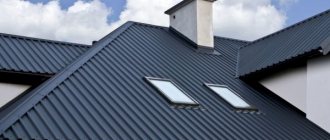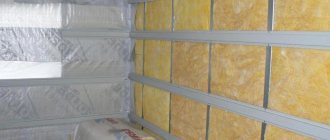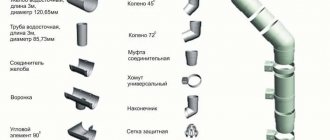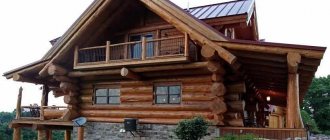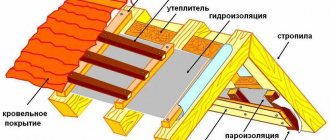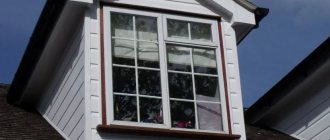Where does waterproofing begin?
Heating devices will operate in a safe mode only if the waterproofing is carried out correctly and taking into account all existing rules and recommendations. Waterproofing is carried out taking into account:
- must be maintained between the rafter system and the roof , which depends on the materials used. Flammable – 150-300 mm, non-flammable – 100-250 mm.
- The sequence of layers in a roofing pie cannot be disturbed. It is necessary to block the possibility of moisture penetrating inside the prepared cake, since any liquid will cause rapid destruction of the layers. The insulation must be separated from the pipe by a gap. Otherwise, there is a risk of fire, since most insulation materials are flammable.
- The box is the required device for separating the roof from the pipe. The distance should be approximately 150 mm. Inside, the created box is filled with any heat-insulating material that has non-flammable properties.
Films that perform insulation tasks must be cut “envelope”, and then pulled to the cross beam so that it can be attached with nails. Waterproofing must be fixed with lathing, vapor barrier - with a special frame. All joints of the box and insulation layers must be edged with special tapes.
Sealing a chimney is a difficult process and requires certain skills and knowledge Source stroy-krov.ru
Consequences of an unsealed joint
To bring the chimney through the roof, a larger diameter is cut out into it, so that a gap remains between the walls of the chimney and the roofing material. Regardless of the width of the gap, it is a big problem faced by homeowners and builders. To eliminate this defect and protect the under-roof space from the penetration of atmospheric moisture, use seals, aprons, collars, made by yourself or purchased. An unsealed gap between the roof and the chimney pipe is fraught with the following consequences:
- Increased wear of roofing material. Most roof waterproofing materials offer better protection against moisture penetration from the outside. Moisture penetrating through an unsealed gap gets onto the inner surface of the roof and eventually destroys it.
- Reducing the service life of the rafter frame. The pouring water hits the elements of the rafter frame, which are made of wood. This leads to rotting and premature destruction of the rafters.
- Reduced insulation efficiency. Roof insulation materials lose their properties when wet, becoming less effective.
- Increased humidity in the attic. Increased dampness in the attic causes heavy, stale air and negatively affects the interior decoration of the room.
Clearance to prevent rafters from catching fire from a heated pipe
Important! The method of sealing the gap between the chimney and the roof depends on its size, the type of roofing material used and the shape of the chimney. If the distance is less than 5 mm, it is quite possible to get by with a heat-resistant silicone-based sealant. You can close a gap whose width is 1 cm or more using cement mortar, an apron, or a special sealant.
How is it carried out?
If the owner of the property notices that a leak appears near the pipe, then in most cases the cause is poor-quality roof sealing. To avoid leaks, specialists install aprons. Installation must be carried out in accordance with the algorithm:
- It is necessary to lay a drainage gutter. It is required to remove moisture from the pipe.
- To ensure maximum tightness of the joint between the roofing and the chimney, an internal apron is used for the pipe on the roof.
- It is necessary to cut out the waterproofing backing , which should be placed under the lower edge of the apron. If the roof is covered with sheet material, then the edge of the substrate must be brought out between the sheets from below. It is imperative to create a side to direct the water along the slope.
- The roof covering must be laid around the pipe.
- using an identical algorithm . The only difference is in securing the top edge to the chimney.
- The insulating apron can be created manually or a ready-made version can be purchased. The chimney must pass inside the apron.
Attaching the apron to the pipe Source banya-ili-sauna.ru
See also: Contacts of construction companies that offer roof repair services.
Making roofing sealant
Before making the adhesive-sealant, wipe the container dry and do a test batch in order to master the technology of the entire process:
- We pour literally 100 grams of gasoline into a bucket, break the foam into small pieces. We carry out all work outdoors.
- We immerse pieces of polystyrene foam in gasoline, which quickly dissolves them. To speed up, stir the substance with a wooden stick.
- As it thickens, the rate of dissolution decreases. Add foam until all the gasoline reacts. At the same time we fix the ratio of materials.
- When the reaction slows down significantly, leave the solution to thicken for 30–40 minutes. During this period, the remaining gasoline will evaporate and the foam will melt.
- If the roofing sealant is too liquid, add more polymer and mix well, then let it settle.
Reference. The technology is based on the ability of various solvents to “corrode” plastic. As a result, the hollow polystyrene granules burst, releasing gas, leaving only pure polystyrene. The polymer is greatly reduced in volume, since the starting material consists of 90–95% voids.
It is noticeable in the photo that the adhesive mass sticks even to smooth plastic.
The thickened polymer sealant becomes very sticky, that is, it has high adhesion to any roofing covering - slate, galvanized steel, profiled sheet, tile. Hence the rule: you need to seal the roof immediately after preparing the sealing solution, otherwise it will thicken greatly. We make the next batch in the required quantity.
Option two: do not pour as much polystyrene foam into the container as possible, but catch the thickened mass from there with a stick and immediately apply it to the roof crack. How polystyrene glue is made and how suitable it is for use, look at the video:
Materials used
The materials used for sealing are divided into three types, each of which has its own advantages and disadvantages.
cotton wool
It is a roll or shortened fibers. Positive qualities of vata:
- soundproofing;
- low density;
- fire resistance;
- adheres tightly to surfaces;
- reduced heat capacity;
- reduced thermal conductivity;
- resistance to physical impact (shock, vibration);
- resistance to chemical attack;
- heat resistance;
- elasticity;
- electrical insulation.
Cotton wool is the most common material for insulation Source 1000dosok.info
Roll filters
They are a mullite-siliceous composition that is included in the fibers of the composition. Positive qualities of roll filters:
- flexibility;
- it is permissible to use inorganic glue;
- easy to cut;
- the mechanical fastening can be firmly fixed.
See also: Contacts of construction companies that offer country house design services.
Asbestos and kaolin boards
In production, mullite-silica fiber is used. The disadvantage of the plates is their immunity to alkalis and acids at high temperatures. To eliminate the deficiency, additional insulation will need to be installed. Positive qualities of the slabs:
- soundproofing;
- low density, but higher than that of cotton wool;
- low thermal conductivity;
- resistance to physical impacts, such as vibrations;
- resistance to steam, water and oils;
- resistance to melting non-ferrous metals;
- elasticity;
- electrical insulating properties will be maintained at temperatures up to 800 degrees Celsius.
Possible ways to eliminate gaps
There are three ways to eliminate gaps between the pipe and the roof:
- A special apron with protective properties. It can be purchased at a specialty store or built.
- Stainless steel passage. It is thrown over the pipe itself, after which the joint that appears must be closed with a clamp.
The joint is covered with a rubber clamp Source uteplovdome.ru
- Silicone sealant. Best suited in cases where the gap is small.
Depending on the materials, sealing methods also change. For example, sealing a pipe on a metal roof is only possible with the installation of an apron. In some cases, depending on the roofing material, individual sealing methods may be used.
Heat-resistant adhesive for sealing: scope of application, characteristics
This type of insulation is suitable for working with external walls of a fireplace, stove, as well as for processing the junction of brickwork and roofing.
It should not be used for stainless steel pipes, since it has a rather low heating temperature - only 350°C.
Heat-resistant sealant is made from silicone. The temperature range at which a product can be used is affected by the additional components present in the product and their percentages. The most common additional component is iron oxide, which gives the insulation a brown tint.
The main characteristics of this type are as follows:
- high elasticity of the thermosealant: due to its resistance to deformation, silicone can be used for insulation on pipe sections of rather complex shape. It will easily cope with the task and will not crack under the influence of temperature;
- the average temperature range of heat-resistant silicone ranges from +250°C to +320°C;
- resistance to ultraviolet radiation: insulation can be used to seal external structural elements;
- silicone does not allow moisture to pass through, which also makes it convenient for outdoor use. Rain and snow are not scary for him;
- high adhesion allows the silicone composition to adhere perfectly to a variety of types of surfaces: brick, metal or ceramics.
Silicone has few disadvantages, but they still exist:
- due to its low heat resistance, it is not suitable for sealing internal surfaces that directly interact with fire;
- Since the material is elastic, it cannot be painted. The paint will not remain on its surface for a long time.
The rate of hardening of heat-resistant insulating material depends on the temperature at which the work takes place. At low temperatures and high humidity, the composition will take longer than indicated on the package. In dry air and high temperature it will harden faster. The insulation also adheres better to a dry surface.
Sealing a square pipe on a slate roof
A slate roof adds its own nuances when it comes to creating a sealed pipe. Because of the slate, it is impossible to use any other parts for insulation, so the protection effect was achieved through a cement-sand apron, which was created as follows:
- All cracks must be covered with galvanized steel collars. This material does not corrode and can last a long time.
- The cement-sand mortar is poured so that it is above the roof level. If a cardboard cylinder was used in the process, then the procedure will be easier and simpler.
- Water drainage must be carried out using an inclined ledge, which must be located on the side of the ridge.
When sealing the chimney, do not forget about the water outlets Source dom.dacha-dom.ru
If, for convenience, a cardboard cylinder with plastic film or a plastic side was used when pouring, then these parts must be removed after the mass has hardened. Despite its appearance, this method of sealing is in no way inferior to alternative ones, which cannot be used on a slate roof.
Sealing round multi-layer chimneys
It is much easier to install sealing on modern round chimneys. The simplicity of the process is due to the fact that no additional equipment is required, since the pipe is already equipped with everything necessary. Installation takes place in three stages:
- Prime the edge of the pipe where the waterproofing will be attached.
- Make a hole in the waterproofing, then glue it to the pipe using mastic.
- The sheet must be attached to the sheathing. The pipe is passed through a cap, between which a clamp with a heat-resistant gasket must be located.
Round metal chimneys Source pinterest.com
If there are no caps, then flexible elastic seals for pipes are used instead. The sealant can also be used anywhere else where roof insulation needs to be improved.
Fire safety precautions when using MASTER FLASH
MASTER FLASH made of silicone can withstand temperatures up to 300 degrees Celsius. This is quite enough to seal a sandwich pipe and, in many cases, a chimney made of asbestos-cement pipe.
The passage through the metal tile is sealed using a Master Flash penetration. Additionally used bitumen tape
As for the metal mono-pipe, in these cases it is possible to use MASTER FLASH in cases where the length of the chimney from the stove to the passage through the roof is at least 3 meters. As a rule, in this situation the temperatures will not be critical, but if not, then thermal insulation of the area that passes through the roofing pie is necessary.
Before reaching the roof, the pipe also passes through the ceiling. It’s not difficult to do the ceiling cutting correctly: there are factory-made feed-through units, but you can do without them. Read how to properly install a chimney through the ceiling here.
Sealing a pipe on a bitumen roof
In this case, the chimney must be sealed using Wakaflex tape. In this case, the following procedure is observed:
- Creating a cutting from tape.
- The cutting is pressed using the case.
- Any gaps that appear must be sealed using bitumen mastic.
Bitumen mastic best protects against bad weather Source www.drive2.ru
Sealing on the roof made of metal tiles and corrugated sheets
Sealing on a roof with such a roof is only possible when using an abutment strip. When sealing a chimney on a corrugated roof, the following procedure must be followed:
- Decide on the installation location of the chimney.
- Partially remove the waterproofing membrane in this area.
- Create a metal apron, which should be assembled from the outer and lower abutment plans.
- Lay roofing material on top.
- The resulting joints must be treated with sealant.
Waterproofing a chimney on a roof covered with metal tiles Source vl-fasad.ru
